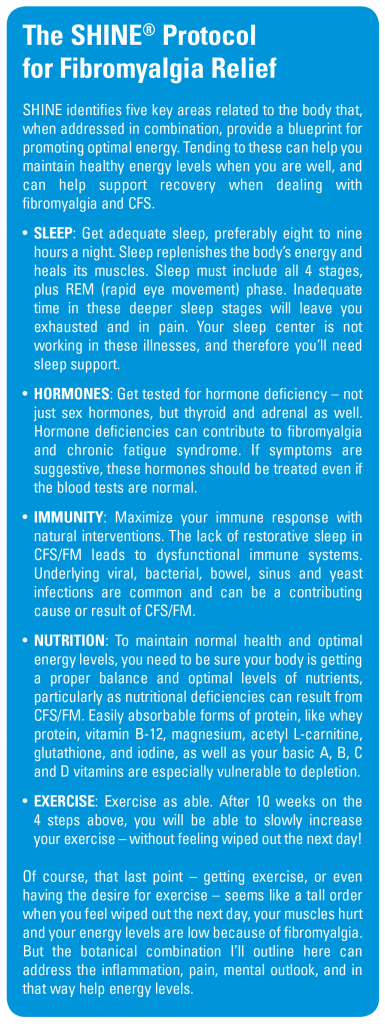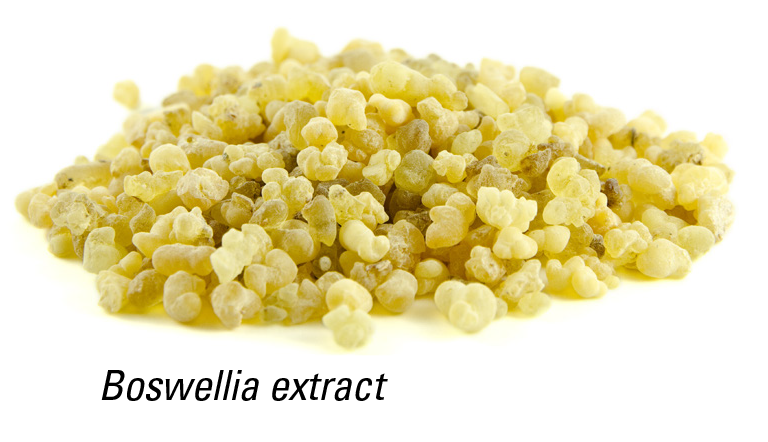BREAK FREE FROM FIBROMYALGIA
INFOMEDICA’S BOTTOM LINE:
Fibromyalgia is characterized by widespread pain throughout the body (with certain tender points where pain is especially acute), fatigue, brain fog, mood imbalances, and sleep disorders. It can be notoriously difficult for people to find a practitioner who can correctly diagnose and treat it, but once they do, treatment can be very effective, if one uses a comprehensive medicine approach.
The botanicals outlined here—curcumin, boswellia, turmerones from turmeric essential oil, and frankincense oil—all address the symptoms of fibromyalgia.
This combination will:
- Reduce pain and damaging inflammation
- Rejuvenate energy levels
- Balance mood and mental outlook
- Clear out “brain fog” and restore clarity

Dr. Jacob Teitelbaum, M.D., is an acknowledged expert on fibromyalgia (FM) and chronic fatigue syndrome (CFS). He is the author of From Fatigued to Fantastic!, Pain Free: 1, 2, 3, and The Fatigue and Fibromyalgia Solution. Having had it himself, he has dedicated his career to finding effective treatments that combine nutrients, natural pain management, healthy sleep, exercise, and adrenal support to help those affected with FM or CFS recover their energy and recapture a vibrant, healthy life. You can contact Dr. Teitelbaum at appointments@endfatigue.com for more information.
Fibromyalgia is not unusual.
The muscle pain, insomnia, brain fog, and fatigue of fibromyalgia can happen to anyone—especially when a person is constantly stressed and required to spend more energy than their body can create. This can include physical stresses such as infections, sleep disorders, hormonal deficiencies, and pregnancies. It can also be caused by situational stresses such as a divorce, a death in the family, or a job loss. Often it is caused by a combination of physical and situational stresses.

But even after a stressful situation appears to have been resolved, pain and dysfunction can linger. This is like tripping a circuit breaker in your home by plugging in too many appliances. The breaker needs to be reset even after you’ve unplugged them. The circuit breaker in fibromyalgia is called the hypothalamus, an almond sized control center in the brain that regulates sleep, hormones, and autonomic functions like blood pressure and gut activity.
Finding a way to overcome fibromyalgia can be a challenge, as most physicians are simply not trained in treating the illness. But effective treatment is available.
Here’s how to get well.
As quoted by Dr. Teitelbaum; “I have been working with people who suffer from fibromyalgia (FM) or chronic fatigue syndrome (CFS) my entire professional life. Having had these myself (they knocked me out of medical school and left me homeless for a year, until I figured out how to recover), I have dedicated the last 40 years to researching this illness and making effective treatment available for everybody.”
From these explorations came a health protocol that Dr. Teitelbaum calls “SHINE®.” This acronym refers to the essentials of what is needed to begin a path toward healing. A published double-blind, placebo-controlled study showed that 91 percent of people improved with an average 90 percent increase in quality of life (a remarkable P < .0001 versus placebo, for those that are statistics oriented).
Additionally, there are some nutrients and botanicals that have proven results in addressing the symptoms of fibromyalgia.

Curcumin for Pain Relief Curcumin from turmeric has been shown in numerous studies to effectively relieve pain.
In a double-blind crossover trial, participants started taking curcumin 2 days before a physical workout and continued for 3 days after. Those taking curcumin noted moderate to large reductions in pain and slightly increased performance (due to the pain reduction). The exercises included gluteal stretches, squat jumps, and single-leg jumps, to get in a variety of controlled movements to replicate the wide range of motions that can cause pain during a workout.
Another recent study looked at the effects of curcumin for adult recreational cyclists. While the physical parameters were harder to judge statistically, participants in the curcumin group reported feeling “better than usual” and less stressed in the training days—2 hours of endurance cycling—versus those taking the placebo—even though the sessions were the same for both groups.
A four-day study featuring curcumin assessed reduction of delayed onset muscle soreness and muscle damage in healthy adults following downhill running—a standard muscle inflammation physical test, and certainly one that can test physical limits.
The pain score in the curcumin group was 17 percent lower compared to the placebo group, and there was less incidence of muscle injury per MRI evidence. Not surprisingly, markers of inflammation and muscle damage tended to be lower in the curcumin group following exercise as well.
Constant stress erodes the ability of the body to produce a protein called brain-derived neurotrophic factor (BDNF). BDNF helps create neurons (important cells in the brain and nervous system) and maintains the existing ones. Aside from that, BDNF is an essential element for brain plasticity (how the brain adapts and learns), and other major functions. BDNF is generally deficient in those with Alzheimer’s, Parkinson’s, and Huntington’s diseases, and issues with the gene for BDNF can also be a component of depression, anxiety, and memory deficits. Curcumin has been shown to significantly increase BDNF after even a short period of use.
Curcumin helps circumvent the conditions of stress by protecting BDNF levels and reducing the stress response. It can help your patient overcome the fatigue, anxiety, and pain so common to fibromyalgia and help them recapture the emotional and physical resilience they need to get back on track.
Some researchers have noted connections between rheumatoid arthritis and fibromyalgia. Curcumin, specifically the curcumin recommended here, has been shown to address that condition, too.
A clinical study focused on the effects of 500 mg twice daily of an enhanced absorption curcumin combined with turmeric essential oil versus the prescription drug diclofenac sodium 50 mg twice daily, or a combination of the two in patients with rheumatoid arthritis. The curcumin group had the best results—the most reduction in joint pain and swelling—and no adverse effects. By contrast, 14 percent of the participants in the drug group stopped the test due to side effects.
Turmerones—Anti-Inflammatory
The curcumin to recommend is blended with turmeric essential oil, which helps increase absorption. Turmeric essential oil contains turmerones (specifically ar-turmerone) which have actions similar to curcumin. In fact, turmerones are a major area of study and research because they have such strong anti-inflammatory and anti-cancer power.

Additionally, turmerones have been found to increase superoxide dismutase and glutathione levels—natural antioxidants produced by the body that have incredible cell-protecting power and could be considered “fountains of youth” for their abilities to keep us healthy regardless of age.
For cognitive health, ar-turmerone may provide a huge advantage. Research shows that it suppresses beta-amyloid, a protein that is responsible for the plaques and tangles in the brain that stop neural connections, and inhibits the inflammatory cytokines and pathways that cause damage to the brain. In other words, it may help prevent Alzheimer’s.
This is primarily due to the ability of turmerones to stop inflammatory cascades in the brain. It can’t be overemphasized just how much inflammation drives our diseases, including the fatigue and accompanying brain fog of fibromyalgia.
Boswellia—Reduce Pain and Inflammation
Unlike conventional drugs, which usually target only a single molecular pathway, boswellia affects multiple pathways in the body. But one of its most important benefits is probably its ability to modulate a particular inflammation pathway called the 5-LOX (5-lipoxygenase) pathway, which leads to significant reduction in inflammation and pain throughout the body.
Combined with curcumin, boswellia has been shown to relieve osteoarthritis pain better than prescription drugs: 64 percent in the herbal group versus 29 percent in the drug group saw a dramatic improvement.
And because boswellia inhibits pro-inflammatory cytokines, it doesn’t just stop pain, it stops the actual damage in joints and muscles.
Choosing the right boswellia is critical. Like many botanicals, boswellia contains specific compounds that are associated with the herb’s beneficial effects. One of boswellia’s most powerful components is acetyl-11-keto-B-boswellic acid, popularly known as AKBA. In fact, in most boswellia research, AKBA is cited as a primary reason the extract works so well to relieve pain and inflammation, treat respiratory conditions, and may even protect the brain against stroke.
Unstandardized boswellia can have as little as one percent AKBA. For the best efficacy, it is important to have a minimum of 10 percent AKBA plus other helpful boswellic acids.
Unfortunately, one of the naturally-occurring compounds in boswellia—beta-boswellic acid—is actually pro-inflammatory. Leaving beta-boswellic acid at its natural levels as found in unstandardized extracts can mean that up to 25 percent of the herb would have an inflammation-causing effect.
A balanced approach is best. Look for a boswellia extract that is standardized so your patient is getting at least 10 percent AKBA and virtually no beta-boswellic acids. This way, they will get a true, complete boswellia with all of the good components they need (but not at artificially high levels) with none of the potentially dangerous amounts of beta-boswellic acid.

Frankincense—Balance Cortisol Levels
In addition to resin extracts, boswellia is also the source of an essential oil – frankincense oil. It is the subject of intensive scientific study for a variety of health applications.
Scientific research with constituents of frankincense oil shows that it may balance cortisol levels and boost BDNF, the same brain protein that curcumin preserves. So aside from being an anti-inflammatory, frankincense can regulate the HPA axis in a way that prevents stress, anxiety, and emotional fatigue from taking hold.
Protein Is Essential
Although we hear more about high protein diets now than we used to, you may be surprised that the need for highly absorbable, bioactive protein—like whey protein—is still a requirement for optimal energy, pain relief, muscle retention, and any type of physical activity and fast recovery. That’s why it’s important to recommend a high quality protein supplement for anyone with FM/CFS. Whey is a good choice, especially when it contains both the isolate and concentrate forms.
Protein helps stabilize blood sugar levels and provides a reliable energy source for your patients throughout the day. One of the reasons that whey protein is a preferred choice is that it is a complete source of amino acids—the building blocks of the cells throughout the body, including the muscles, nerves, and brain.
Whey protein has been shown to boost lean muscle mass, reduce inflammation, and help increase strength, especially in individuals who have lost some of their former muscle tone through inactivity. There is a difference that whey protein can make in individuals with FM/CFS, and your patients will notice a difference once they incorporate it into their daily regimen. Recommend a whey protein that provides both concentrate and isolate forms, combined with pain-fighting curcumin and boswellia.

You Can Overcome Fibromyalgia
FM/CFS are frustrating conditions. It’s not unusual for people to try many approaches before discovering the one the works best for them.
But don’t let your patients give in to despair and hopelessness. The start of the road back to better health is found in the proper application of clinically validated nutrients and botanicals, a review of the SHINE® protocol, and sensible exercise. Activity is critical for a mentally and physically healthy life and outlook, and will be much easier to do once their energy levels increase with treatment!
Dr. Teitelbaum has treated thousands of people with this illness, and does both in-person and phone consultations with people worldwide. (See contact information in bio). Research and clinical experience have shown that 85 percent of people improve significantly, and usually markedly, with the proper treatment.
The bottom line is that your patients can get their life back!
Curcumin, boswellia, turmeric essential oil, and frankincense oil promote health—they don’t just block an unwanted condition. All of these botanicals reduce the oxidative stresses and inflammation at a cellular level and heal muscle damage, stop pain, and help feel re-energized. Explore these natural ingredients for fibromyalgia and chronic fatigue syndrome with your patients. These botanicals could make a world of difference and help them feel physically and mentally vibrant again.
To help address the fatigue, brain fog, and sleep disorders associated with fibromyalgia and chronic fatigue syndrome, recommend taking high absorption curcumin, a uniquely standardized boswellia resin extract, turmerones from turmeric oil, and frankincense oil twice daily.
For additional information, go to: Finding Fibromyalgia Relief


